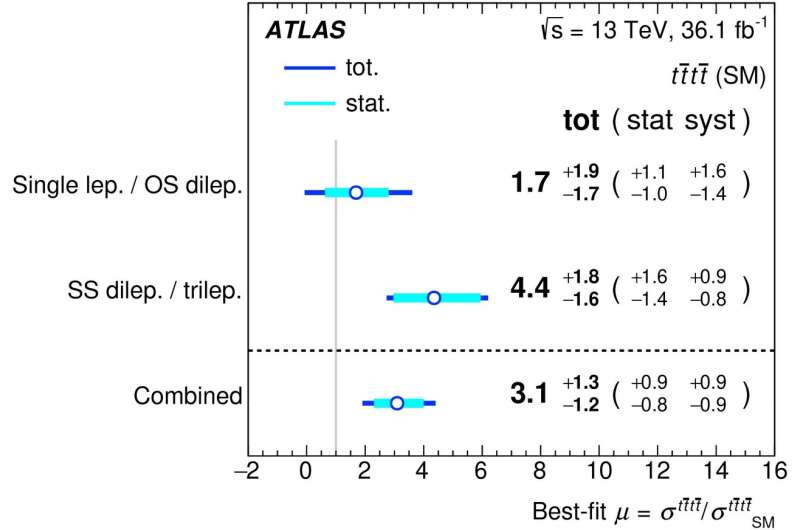Rate of the four-top-quark production in units of the Standard Model prediction measured by the ATLAS Experiment, for the different analysed final states and their combination. Credit: ATLAS Collaboration/CERN
For several decades, particle physicists have been trying to better understand nature at the smallest distances by colliding particles at the highest energies. While the Standard Model of particle physics has successfully explained most of the results produced by experiments, many phenomena remain baffling. Thus, new particles, forces or more general concepts must exist and – if the history of particle physics is any indication – they could well be revealed at the high-energy frontier.
A promising testbed for such new physics is "four-top-quark production," an elusive Standard Model process that has not yet been observed experimentally. In this production, two pairs of top quarks – the heaviest-known elementary particles – are simultaneously created in a collision, thus concentrating a huge amount of energy in a single point. This is so rare that, in the dataset of 30 million top-quark pairs analysed by the ATLAS experiment at CERN for this study, only around 350 collisions are expected to have produced four top quarks.
The ATLAS collaboration just released its latest results on the search for four-top-quark production based on proton-proton collision data collected in 2015 and 2016 at the Large Hadron Collider (LHC). As a top quark decays, it gives rise to "final states" with either three (lighter) quarks or a quark, a neutrino and a charged lepton. Hence, events where four top quarks are produced simultaneously can have very different final state topologies depending on the combination of these decays. ATLAS physicists analysed these topologies individually before combining them for the final result.
All of these final states are characterised by the presence of many highly energetic particles. While this makes the four-top signal signatures easier to distinguish from background processes, it also makes it harder to predict how many background events are misidentified as four-top-quark-production events. ATLAS teams thus implemented sophisticated new analysis techniques to estimate the amount of background in these "busy" environments. In combination with the excellent detector performance, a result with unprecedented sensitivity was achieved, excluding a signal with a production rate larger than 2.1 times the rate predicted by the Standard Model (to be compared with a factor of 11.6 for the previous most sensitive search).
The data analysis resulted in a small, not yet significant four-top signal of 2.8 standard deviations giving an observed upper limit of 5.3 times the Standard Model rate. Could this be a hint or simply a statistical fluctuation? Only an updated result using the larger available dataset and an even smarter analysis can tell.
More information: ATLAS Collaboration. Search for four-top-quark production in the single-lepton and opposite-sign dilepton final states in proton-proton collisions at 13 TeV with the ATLAS detector: arXiv:1811.02305 [hep-ex]. arxiv.org/abs/1811.02305
Provided by ATLAS Experiment
























